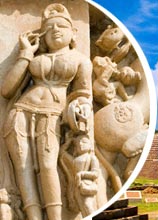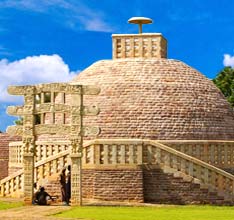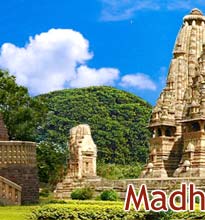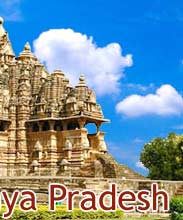 Madhya
Pradesh is a melting pot that embraces people professing different
religions. Thus, the state is home to many important worship places in
India. The religious places strewn across the state are popular for
their mystical overtones as well as for their architectural
magnificence. Some of the most splendid temples, mosques and monasteries
in India adorn the landscape of Madhya Pradesh and heighten its
popularity amongst religious travelers. Every year, many devotees flock
to these religious destinations across the state, for offering their
homage to Divinity.
Madhya
Pradesh is a melting pot that embraces people professing different
religions. Thus, the state is home to many important worship places in
India. The religious places strewn across the state are popular for
their mystical overtones as well as for their architectural
magnificence. Some of the most splendid temples, mosques and monasteries
in India adorn the landscape of Madhya Pradesh and heighten its
popularity amongst religious travelers. Every year, many devotees flock
to these religious destinations across the state, for offering their
homage to Divinity.These religious places, bequeathed from various dynasties, also exhume the rich historical past of Madhya Pradesh that traverses many centuries. They stand as allegories to the period they belong to and unravel the architectural modes preferred by different dynasties. Thus, religion and art have blended and contributed to the creation of these architectural marvels of Madhya Pradesh. This article will help you to explore more on the various worship places in Madhya Pradesh and embark on a spiritual voyage to the state.
Bada Ganpati Temple
Built in the year 1875, Bada Ganpati Temple of Indore is dedicated to Lord Ganesha. As the name indicates, the temple enshrines the largest statue of 'Ganapati' or Lord Ganesha in the whole world. The massive bright-orange idol measure 8 m from crown to foot and is made of metallic frames like gold, silver, copper, brass and iron.
Bade Ganeshji Ka Mandir
An important landmark of Ujjain, this Hindu temple enshrines a large ornate idol of the Hindu deity 'Ganesha'. The highly wrought idol of the elephant God, believed to be one of his largest sculptured images, is a major attraction amongst tourists. The place also harbors the only 'panchmukhi' (five-faced) statue of Lord 'Hanuman' within its precincts.
Buddhist Temples
Built to eulogize the teachings of Buddha, Buddhist temples of Sanchi display various poses of Buddha, in his journey towards salvation. These prehistoric temples are stamps of Gupta art and architecture and are prominent attractions of Sanchi. Different symbols pertaining to Buddhism and various religious inscriptions make the place a haven for spiritual travelers.
Buddhist Vihara
Buddhist Vihara, located a few kilometers from Sanchi, is a famous religious site of the Buddhists. The sacred relics of the Satdhara Stupa, placed inside a glass coffer in a platform of the inner sanctum, comprise of the main site of worship. The Vihara also serves as a house of residence for the monks who pursue religious studies here.
Chatarbhuj Mandir
This famous Hindu shrine of Gwalior was built in AD 876. It commemorates Lord Vishnu and houses a colossal idol of the deity. The architectural adroitness of the shrine coupled with its religious halo is indeed awe-inspiring. Steep steps lead to the roof of the temple, which is ideal for witnessing the beauty of the surrounding environs dotted with villages and buildings.
Mahakaleshwar Temple
Consecrated by one of the twelve 'jyotirlingas' in India, Mahakaleshwar Temple of Ujjain evokes ardent religious sentiments. It displays magnificent 'shikhara', highly stylized facades and houses finely carved idols of various Hindu deities, along with Shiva. On the day of 'Mahashivratri', a huge fair organized near the temple attracts a lot of devotees.
Chintaman Ganesh Mandir
Chintaman Ganesh Mandir, dedicated to Lord Ganesha, dates back to the 11th- 12th century and exhibits the grandeur of Paramara architecture. The temple is entirely carved of stone and houses a 'swayambhu' (self-manifested) idol of Lord Ganesha, accompanied by his two wives viz. Riddhi and Siddhi, inside the 'Garbhgriha'.
Harsiddhi Temple
One of the most famous 'Shaktipeeths' of India, Harsiddhi temple of Ujjain enshrines a vermilion colored idol of Goddess 'Annapurna', placed between the idols of Goddess Laxmi and Goddess Saraswati. The temple site is believed to be the place where Goddess Sati's elbow fell, when Lord Shiva carried away her body from the sacrificial fire.
Jain Temple
Amongst the many mosques and monuments that crown the fort town of Mandu, Jain Temple is unique, as it is the only non-Muslim monument of the place. This modern temple complex enshrines embellished images of various Jain 'Tirthankars' in marble, silver and gold. There is also a Jain Museum adjoined to the templ, with a walk-on replica of the 'Palitana'.
Jama Masjid
Built by Qudisiya Begum in 1837, Jama Masjid is a milestone monument of Bhopal. Its towering minarets soar to great heights and are visible from a large distance. Three bulbous cupolas crown the monument and highlight its brilliant architectural exposition. The interior of the mosque, with its marble-sheathed inner sanctum, is a marvelous example of Islamic architecture.
Moti Masjid
Moti Masjid of Bhopal has a striking resemblance to the Jama Masjid of New Delhi. Built by Sikandar Jahan in 1860, Moti Masjid brings to light the heights attained by Islamic art and architecture. Fabricated with red sandstone, its highly stylized structure is a prototype of Muslim architecture. It has an arresting marble façade, with two red minarets crowned by golden spikes.
Jata Shankar Temple
Jata Shankar Temple is one of the most frequented tourist destinations of Pachmarhi. It is actually a sacred cavern, cramped under a mass of loose boulders. The place is named 'Jatasankar' as a rock formation here resembles the tangled manes of Lord Shiva. 'Samadhistha Shiva', housed in this dark cave, resembles the hood of a serpent and is a site of arcane awe and reverence.
Kal Bhairava Temple
Sited in the Ujjain District of Madhya Pradesh, Kal Bhairava Temple is believed to be the brainchild of King Bhadrasen. Dedicated to Kal Bhairava, the chief among the eight Bhairavas, this temple lies on the holy banks of the Shipra. It is a venerated pilgrim site, especially for people of Shaivite tradition. Relics of paintings in Malwa style is a striking feature of this temple.
Lakshmi Narayan Temple
Lakshmi Narayan Temple of Bhopal commemorates the Hindu deities Lakshmi and Vishnu. Popularly known as Birla Temple, this sandy-yellow edifice houses idol of many Hindu Gods and Goddesses and radiates spiritual wealth. Along with the blessed aura of the place, its beautifully carved archway and green lawns make it a famous tourist draw of Bhopal.
Saas- Bahu Temple
Saas-Bahu temple of Bhopal is dedicated to Lord Vishnu and is known for its spiritual significance and magnificent beauty. Built in 11th century, its name can be a misnomer, as it metaphorically and traditionally implies to two temples of different sizes, adjoined to each other. These temples display intricate artwork and richly carved statues.
Teli Ka Mandir
A Pratihara Vishnu temple, Teli Ka Mandir was built in the 9th century A.D. The structure mounts to a height of 100ft and displays a unique architectural pattern, with fine amalgam of Dravidian and Indo-Aryan characteristics. The roof of the temple is distinctly Dravidian, whereas the carved adornments radiate strong Indo-Aryan appeal.
Taj-ul-Masjid Bhopal
Believed to be one of the largest and most elaborately patterned mosques in India, Taj-ul-Masjid literally means 'The Crown of Mosques'. With its pink façade and white-domed minarets, it elevates to great heights and stands as a stunning ovation to the rule of Begums in Bhopal. Constructed under the regime of Shah Jehan Begum, the monument however saw completion only after her death.









